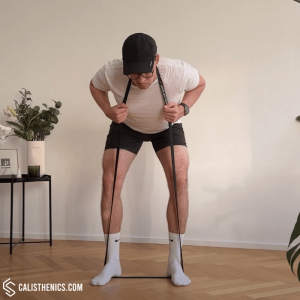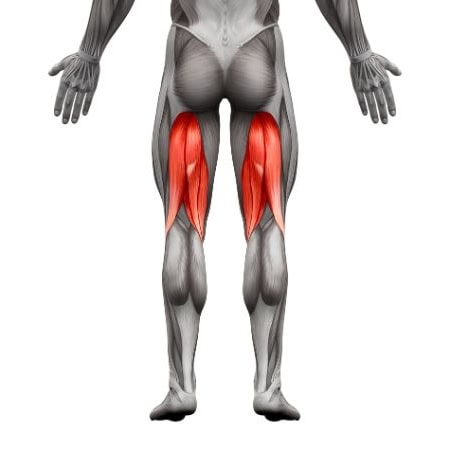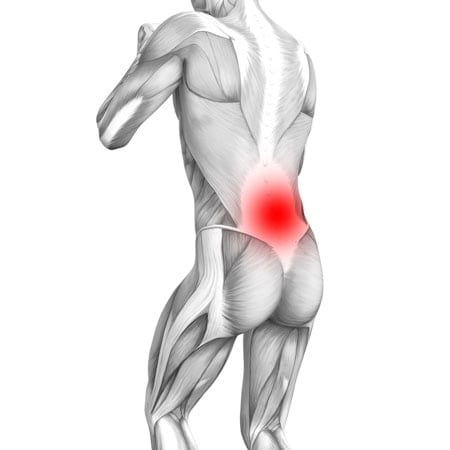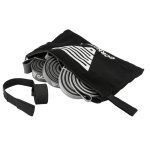Banded Good Mornings
How to do Banded Good Mornings?
Banded good mornings are a highly effective lower-body and posterior chain exercise that targets the hamstrings, glutes, and lower back. This movement mimics a hip hinge pattern while using a resistance band for added tension, making it a great exercise for building strength, improving hip mobility, and enhancing core stability. The banded good morning is a versatile exercise that can be done at home or in the gym and is often used for warming up, as part of a lower-body strength routine, or to improve posterior chain endurance.
Steps to Perform a Proper Banded Good Morning:
1. Set Up with the Resistance Band:
• Stand with your feet hip-width apart, and place a resistance band around your neck and shoulders, holding the other end of the band under both feet.
• Make sure the band is secured under your feet and evenly distributed across your shoulders, ensuring that the tension is consistent on both sides.
2. Engage Your Core and Set Your Posture:
• Stand tall with a slight bend in your knees, engaging your core by pulling your belly button toward your spine to stabilize your torso.
• Keep your chest up and your shoulders pulled back, maintaining a neutral spine.
3. Hinge at the Hips:
• Inhale as you begin to hinge at your hips, pushing your hips backward while keeping your chest lifted. Your knees should remain slightly bent, but your legs should not move.
• Lower your torso toward the ground while maintaining a flat back. Your body should resemble a tabletop at the bottom of the movement, with your torso nearly parallel to the ground.
• Keep your core tight and your back straight throughout the movement.
4. Drive Through Your Hips to Stand Back Up:
• Exhale as you push through your heels and extend your hips forward to return to the standing position.
• Squeeze your glutes at the top of the movement to fully engage your posterior chain.
5. Repeat the Movement:
• Perform the desired number of repetitions, maintaining controlled, smooth movements throughout the exercise.
Benefits of Banded Good Mornings
• Strengthens the Posterior Chain: Banded good mornings target the hamstrings, glutes, and lower back, helping to build strength and endurance in the muscles that support proper posture and hip extension.
• Improves Hip Hinge Mechanics: The hip hinge is a fundamental movement pattern for many exercises, including deadlifts and squats. Practicing good mornings helps improve your hip hinge mechanics, making you more efficient and reducing the risk of injury in other movements.
• Enhances Core Stability: This exercise engages the core throughout the movement, promoting core stability and helping to protect the lower back during hip-hinging movements.
• Boosts Mobility: Good mornings improve hamstring and hip mobility by stretching and strengthening the muscles in the posterior chain, which can help enhance flexibility and reduce stiffness.
• Increases Lower Back Strength: Strengthening the lower back with exercises like banded good mornings helps reduce the risk of lower back pain, especially in individuals who sit for long periods or experience poor posture.
• Low-Impact: The banded good morning is a low-impact exercise, making it suitable for individuals recovering from injury or those looking for a gentler way to build lower-body strength.
• Versatile and Accessible: All you need for this exercise is a resistance band, making it easy to perform at home, in the gym, or while traveling.
Common Mistakes to Avoid
• Rounding the Back: Avoid rounding your lower back as you hinge forward. Keep your core engaged and your spine neutral to prevent lower back strain and ensure proper form.
• Bending the Knees Too Much: Good mornings are a hip hinge exercise, not a squat. Avoid bending your knees excessively; instead, focus on pushing your hips back.
• Using Momentum: Perform the movement with control rather than using momentum to swing back up. The focus should be on muscle engagement, not speed.
• Letting the Band Slip: Ensure that the resistance band is securely placed under your feet and across your shoulders to avoid any slipping or uneven tension.
• Hyperextending the Spine: Avoid overextending your spine at the top of the movement. Stand tall but avoid arching your lower back when you return to the standing position.
Tips for the proper execution of Banded Good Mornings
Engage the Core: Keep your core tight throughout the exercise to protect your lower back and maintain proper spinal alignment.
Push the Hips Back: Focus on hinging at the hips, rather than bending at the knees, to maximize engagement of the hamstrings and glutes.
Maintain a Neutral Spine: Avoid rounding your lower back. Keep your spine in a neutral position by engaging your core and keeping your chest lifted.
Control the Movement: Perform the movement slowly, especially when lowering your torso. Control the resistance from the band to maximize muscle engagement.
Breathing: Inhale as you hinge forward, and exhale as you stand back up. Proper breathing helps maintain core stability and ensures smooth movement.
Muscles worked when doing Banded Good Mornings
Primary Muscles:
•Hamstrings: The hamstrings are heavily engaged during the hip hinge, especially as you lower and lift your torso.
•Glutes: The gluteus maximus and medius are activated when you extend your hips and drive back to the standing position.
•Lower Back: The erector spinae muscles stabilize the spine and support the lower back throughout the movement.
Secondary Muscles:
•Core: The abdominals and obliques are engaged to stabilize the torso and maintain proper posture during the movement.
•Quadriceps: Assist in maintaining stability during the movement, particularly by supporting the knees.
•Hip Flexors: Assist in controlling the descent and ascent of the torso.
•Calves: Provide additional stability during the exercise, helping to balance the lower body.
Primary Muscle(s):
Secondary Muscle(s):
Adjust the difficulty of Banded Good Mornings
How to make Banded Good Mornings harder?
How to make Banded Good Mornings easier?
How to make Banded Good Mornings harder?
To make Banded Good Mornings harder:
-
Use a Heavier Resistance Band: Switch to a band with more resistance to increase the intensity and challenge your posterior chain further.
-
Increase Time Under Tension: Slow down the lowering phase of the movement to increase time under tension, further engaging your hamstrings, glutes, and lower back.
-
Add a Hold at the Bottom: Pause at the bottom of the movement (with your torso parallel to the ground) for 2-3 seconds before standing back up. This increases muscle engagement and builds endurance.
-
Perform More Repetitions or Sets: Increase the number of repetitions (e.g., 15-20) or sets to challenge your endurance and strength.
How to make Banded Good Mornings easier?
To make Banded Good Mornings easier:
-
Use a Lighter Resistance Band: Start with a lighter resistance band to reduce the tension and make the exercise more manageable, especially if you’re new to the movement.
-
Perform Partial Range of Motion: Instead of lowering your torso all the way to parallel with the ground, perform partial good mornings by hinging just halfway. This reduces the intensity and helps build strength gradually.
-
Focus on Bodyweight: If the resistance band is too challenging, practice bodyweight good mornings without the band to perfect your form before adding resistance.






